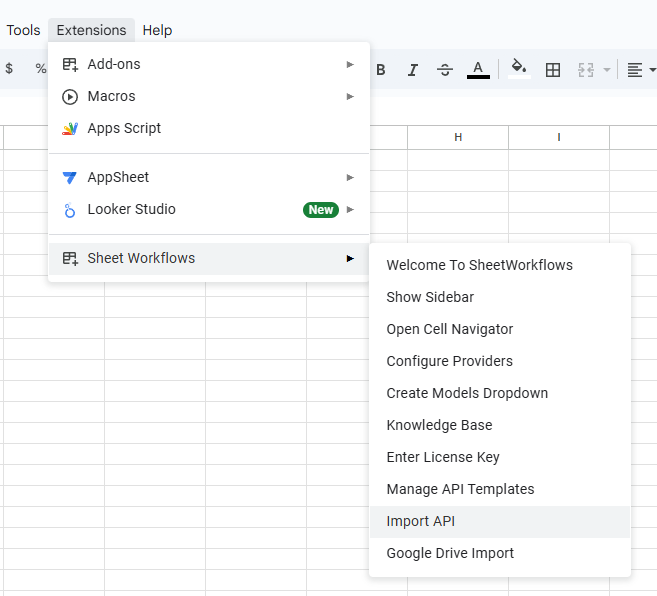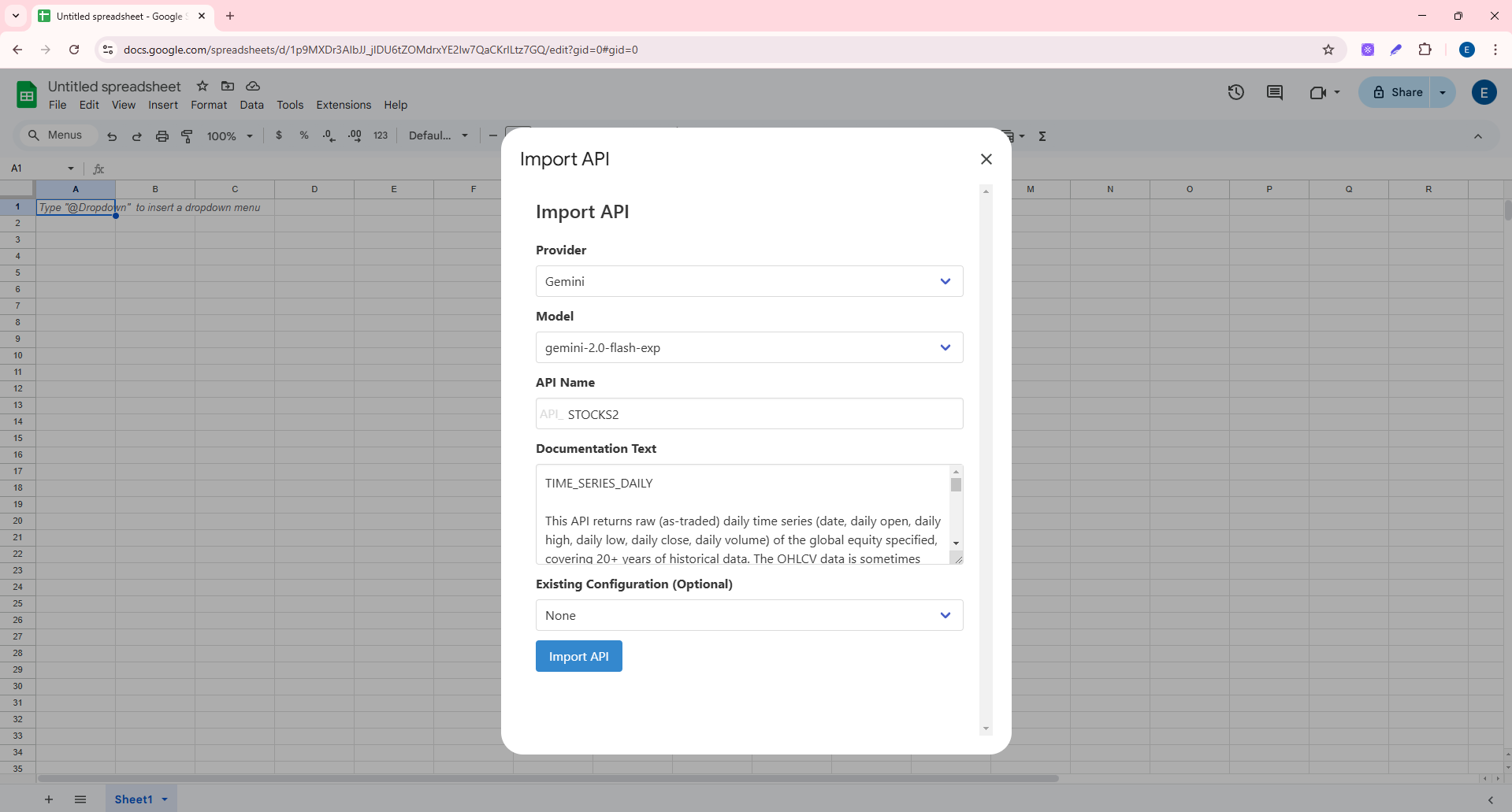Importing an API
Importing an API
This knowledge base entry explains the “Import API” feature of the Sheet Workflows add-on. It provides an overview, step-by-step instructions, examples, and troubleshooting advice tailored for non-technical users.
Purpose
The Import API screen allows you to add and configure an external API integration within your Google Sheets. By entering the required details (such as API name, provider, model, and documentation), the add-on automatically generates an API template, creates a configuration, and builds an API form. In short, it automates creating custom API functions that then appear in your sidebar for easy access during your workflow.
Context
You can access the Import API screen via the add-on menu by selecting the “Import API” option. This screen fits into your common workflows by:
- Enabling you to quickly integrate new APIs without writing any code.
- Allowing you to adapt external API functionalities into your spreadsheets.
- Simplifying configuration—the add-on creates multiple components (template, config, and form) that let you call the API as a custom function.
- Acting as a bridge between your API documentation and the functional custom API in Sheets.
Quick Access Screenshot:

Import API Screen Screenshot:

Step-by-Step Procedures
1. Open the Import API Screen
- Click on the Sheet Workflows add-on menu.
- Select the option “Import API” to open the screen.
2. Fill Out the Form Fields
- Provider Dropdown:
Choose the API provider from the dropdown. If you’ve used some providers recently, they will appear under “Recent.” - Model Dropdown:
Once the provider is selected, a list of available models appears. Pick the appropriate model for the API. - API Name:
Enter a unique name for your API. The field is pre-populated with “API_” as a prefix. - Documentation Text:
Paste or type the API documentation. This text is used to generate the API template and explain placeholder parameters. - Existing Configuration (Optional):
If you already have a configuration set up for an API, you can select it from this dropdown. Leaving this blank will create a new API configuration.
3. Import the API
- After completing the form, click the Import API button.
- The add-on will start processing. You will see notifications indicating the status:
- “API template created successfully”
- “API config created successfully”
- “API form created successfully”
- If any errors occur (for template, config, or form), error messages will display in red notifications.
4. Finalizing
- When the API is imported successfully (and if no existing configuration was used), you may be prompted to configure additional settings.
- A button labeled Show Sidebar will appear. Click it to open the sidebar, which lists your newly imported custom API functions for easy access.
Use Cases / Examples
-
Integrating External Data:
Suppose you want to use a weather API to pull real-time data into your spreadsheet. You would access the Import API screen, choose the weather API provider and model, enter a descriptive API name (e.g., “API_WeatherData”), and paste the API documentation. Once imported, the weather API appears in your sidebar for quick insertion into cells. -
Automating Repetitive Tasks:
If your workflow involves frequently calling a custom function (like sending notifications through an external messaging API), importing the API once and configuring it through this screen saves you from having to manually build function calls every time. -
Rapid Prototyping of API-driven Functions:
When testing new APIs, simply paste in the API documentation and import it. The add-on generates a template that you can later adjust using the configuration form provided.
Common Issues
- Incomplete Field Entries:
If one or more required fields are left empty (e.g., Documentation Text or API Name), the process will not proceed. - Template Generation Errors:
The API template creation might fail if the documentation text is not formatted as expected. - Configuration Issues:
Errors may occur while copying an existing configuration or creating a new one. - Slow Provider/Model Loading:
Sometimes the dropdowns for providers or models will show “Loading providers…” or “Loading models…” if there is a delay in fetching data.
Troubleshooting Steps
- Verify Input Fields:
Double-check that every required field is filled out correctly. The API Name, Provider, Model, and Documentation Text must be provided. - Monitor Notifications:
Read the popup notifications carefully. They inform you which step (template, config, or form) might have encountered a problem. - Retry Import:
If an error notification appears, try re-submitting the form. Sometimes network issues or delays in the provider’s API can cause temporary failures. - Check Existing Configurations:
If using an existing configuration, ensure that the configuration name is correct and that it contains valid settings. - Contact Support:
If issues persist after verifying inputs and retrying, consider reaching out to the add-on support team with the error details provided in the notifications.
FAQs
Q: How do I access the Import API screen?
A: Open your Google Sheet, click on the Sheet Workflows add-on menu, and select “Import API.”
Q: What information is required to import an API?
A: You need to provide an API name, choose a provider and model from the dropdowns, and paste the API documentation. Optionally, you can select an existing configuration.
Q: What happens after I click “Import API”?
A: The add-on will generate an API template from your documentation, create a configuration, and build an API form. Notifications will inform you if each step is successful.
Q: I see error notifications. What should I do?
A: First, verify that all required fields are complete and correctly formatted. Then, try again. If the problem persists, follow the troubleshooting steps or contact support.
Q: Can I use an existing configuration?
A: Yes. If you have a previously saved configuration, select it from the “Existing Configuration” dropdown. If left unset, a new configuration is generated.
By following these steps and tips, you can seamlessly integrate APIs into your Google Sheets using Sheet Workflows—without needing any technical expertise. Enjoy automating your spreadsheet processes with custom API functions!
9 months ago
9 months ago